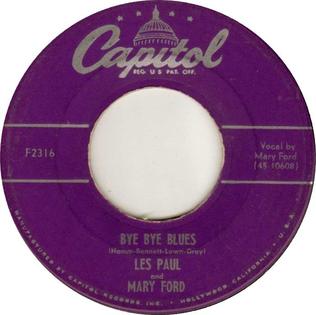Related Research Articles
"On the Atchison, Topeka and the Santa Fe" is a popular song written by Harry Warren with lyrics by Johnny Mercer. The song was published in 1944, spanned the hit chart in mid-1945, and won the 1946 Academy Award for Best Original Song, the first win for Mercer.
"Slow Poke" is a 1951 popular song.
"Too Young" is a popular song. The music was written by Sidney Lippman, the lyrics by Sylvia Dee. The song was published in 1951.
"You Can't Be True, Dear" is a popular German song.
"Mam'selle" is a bittersweet song about a rendez-vous with a "mam'selle" (mademoiselle) in a small café. The music was written by Edmund Goulding, the lyrics by Mack Gordon.
"April in Portugal" is a popular song, also named "The Whisp'ring Serenade." The music was written by Raul Ferrão with Portuguese lyrics by José Galhardo as a fado named "Coimbra", about the city of that name in 1947. English lyrics written by Jimmy Kennedy were set to the music, though many of the most popular versions of the song were instrumentals. It is one of the signature songs of Portuguese singer and fadista Amália Rodrigues. It was also recorded in French by the tenor Luís Piçarra.
"Sentimental Me" is a popular song which was written by James T. Morehead and James Cassin and published in 1949.
"I'm Yours" is a 1952 popular song by Robert Mellin. Recordings of it were made by Eddie Fisher, Don Cornell, The Four Aces, and Toni Arden.
"Cruising Down the River" is a 1946 popular recording song, which became the winner of a public songwriting competition held in the UK. Words and music were entered by two middle-aged women named Eily Beadell and Nell Tollerton. The words had been written by Eily in the 1920s, and the melody composed by music hall artist Ena Dayne; as she could not read music, it was transcribed by Tollerton. It was sung in concert parties throughout the 1930s, mainly by Charles Ray. One of the original early recordings of this song, issued in the UK in January 1946 on the Columbia record label, was by Lou Preager and his Orchestra, with vocal by Paul Rich. This was immensely popular on radio, with record and sheet music sales making it one of the biggest hits of 1946 in the United Kingdom.
"I Can't Begin to Tell You" is a popular song with music written by James V. Monaco and lyrics by Mack Gordon. The song was published in 1945.
"Far Away Places" is an American popular song. It was written by Joan Whitney and Alex Kramer and published in 1948.
"Serenade of the Bells" is a popular song written by Kay Twomey, Al Goodhart, and Al Urbano and published in 1947.

"Amor", also known as "Amor Amor" and "Amor Amor Amor" is a popular song.
"(I Love You) for Sentimental Reasons" is a popular song written by Ivory "Deek" Watson, founding member of the Ink Spots, also founding member of The Brown Dots and William "Pat" Best, founding member of the Four Tunes.

"Near You" is a popular song written and originally recorded by Francis Craig and His Orchestra at Castle Studio in 1947, with lyrics by Kermit Goell, that has gone on to become a pop standard.
"The Old Lamp-Lighter" is a popular song. The music was written by Nat Simon, the lyrics by Charles Tobias. The song was published in 1946.
"You Won't Be Satisfied " is a popular song.
"That's My Desire" is a 1931 popular song with music by Helmy Kresa and lyrics by Carroll Loveday.
"Someday You'll Want Me to Want You" is a popular song published in 1944 by Jimmie Hodges. The song became a standard, recorded by many pop and country music singers.

"Bye Bye Blues" is a popular and jazz standard written by Fred Hamm, Dave Bennett, Bert Lown, and Chauncey Gray and published in 1925.
References
- 1 2 3 Whitburn, Joel (1973). Top Pop Records 1940-1955. Record Research.
- ↑ "Pop Chronicles 1940s Program #17".
- ↑ Whitburn, Joel (1986). Joel Whitburn's Pop Memories 1890-1954. Menomonee Falls, Wisconsin: Record Research Inc. p. 264. ISBN 0-89820-083-0.
- ↑ "Internet Movie Database". imdb.com. Retrieved March 23, 2020.